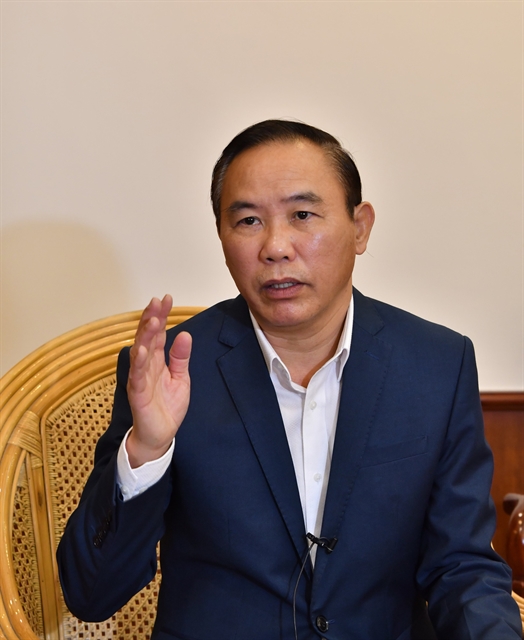 Opinion
Opinion


|
| Deputy Minister of Agriculture and Rural Development Phùng Đức Tiến. VNS Photo Tố Như |
The domestic pig-raising industry not only meets the needs of 100 million people but also targets the export market, in which, building a disease-free area is a prerequisite. Việt Nam News reporter Trần Tố Như talks with Deputy Minister of Agriculture and Rural Development Phùng Đức Tiến about the plan.
How is the supply of pork recently?
In the first half of the year, pork production reached 2.32 million tonnes, increasing by 5.4 per cent over last year. The total pig herd is 2.486 million heads. Pork prices have increased over a one-month period and ranged from VNĐ60,000 to 67,000 (US$2.54-2.83) per kilo.
Based on the actual situation, the ministry will have solutions to prepare source food during the Tết (Lunar) New Year when food demand usually increases by 15 to 20 per cent.
The first is the issue of breeds.
For many years, research institutes and centres, and firms have focused on the job relatively well. The reproductive rate currently reaches 28 to 32 heads per sow on average.
In terms of animal feed, the prime minister has asked the ministry to build up an independent, autonomous and integrated industry, especially in the context that we are importing a huge amount of animal feed.
The problem now is to build a raw material area to reduce dependence and costs of warehousing, as well as to lower interest rates and logistic fees thereby controlling the price of animal feed. Currently, animal feed accounts for a whopping 65-70 per cent of the cost of livestock.
The ministry is directing corporations to focus on the Tây Nguyên (Central Highlands) provinces to build material areas of cassava, corn and soybean.
The third is the solution of veterinary medicine and disease prevention. In recent years, we have done well in veterinary work and disease prevention with the production of foot-and-mouth vaccines, blue-eared pig vaccines and the African swine fever vaccine.
Animal slaughtering and processing is an important factor as well. The pork processing model of Masan Group Joint Stock Company is an example. The processing model helps increase the added value of products by up to 31 per cent.
Therefore, along with the development of breeds, animal feed, veterinary medicine, and disease control, processing is also very important.
We should not only think of 100 million domestic customers but also consider pushing up exports by applying technology to a closed chain and circular economy.
Currently, Việt Nam's agricultural products have been exported to nearly 200 markets, there is no reason why our pork and poultry meat cannot be exported with a larger output.
Although we have exported chicken to many countries including Japan, the amount is still limited.
It is necessary to build epidemic-free zones, and better slaughtering and processing industries so that we can expand export markets.
The export turnover of livestock products reached US$409 million last year and US$232 million for the first half of this year.
This is a very good sign but we need to accelerate more so that we can export pork and other meat products.
These are the key solutions to improve competitiveness meeting the needs of the domestic market and aiming for more exports in the near future.
Tell us about the plan to build disease-free breeding in line with the standards of the World Organisation for Animal Health.
According to OIE’s regulations on animal raising and animal product exports, the animals must be raised in safe environments. The construction of disease-free zones must meet the criteria outlined by international markets.
We have to focus on building such areas in the southeast region as it has a very large scale of poultry and pig farming.
Currently, De Heus Vietnam Co., Ltd., has signed a cooperation agreement with the ministry to build a disease-free breeding area including preparation of planting areas, and varieties, setting up cooperatives, and building warehouses for processing and storage.
In the near future, the ministry will chair a conference with the Tây Nguyên provinces and De Heus Vietnam Co., Ltd., to realise the agreement.
What is the roadmap for building free-disease zones in the southeast region?
We have been building free-disease zones for many years and have had great results.
For example, our pork has been exported to Korea and Hong Kong and chicken to Japan.
However, maintaining and expanding zones is now a problem.
This expansion involves many localities that have to understand the criteria for building epidemic-free zones.
What are the difficulties and challenges in building disease-free livestock?
Việt Nam’s livestock industry is still on a small scale with traditional methods of open animal lodgings that cause difficulties for disease safety and bio-security management.
The average vaccination rate must reach over 80 per cent to meet the requirements for immunity. But our rate is lower than this level.
The implementation of biosecurity measures in farm and waste management needs to be strictly adhered to.
Small and scattered farming and the modest awareness of farmers and businesses are hindering the building of disease-free zones.
To develop agriculture, we need to raise the awareness of businesses, farms, cooperatives, and farmers.
This is a very valuable lesson from Europe.
When I had a meeting with the High Commissioner of Agriculture and Rural Development of the European Union (EU), he shared that in 2003 and 2004, the union demolished cooperatives, but now it has had to restore the production model.
Along with maintaining the ecosystem, businesses must play a key role to help farmers and households develop sustainable agriculture.
Large-scale enterprises themselves, especially foreign direct investment firms, understand that building disease-free zones is a prerequisite for exporting products. VNS




